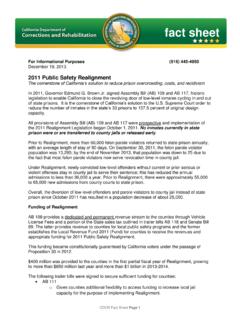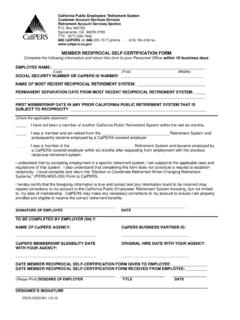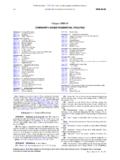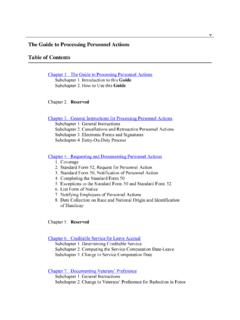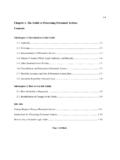Transcription of Department Operations Manual Chapter 5
1 Operations Manual Department OF CORRECTIONS AND rehabilitation Chapter 5 325 Chapter 5 ADULT CUSTODY AND SECURITY Operations ARTICLE 1 PEACE OFFICER AUTHORITY Revised February 29, 2009 Policy It is the policy of the california Department of Corrections and rehabilitation (CDCR) to ensure that CDCR peace officer authority comports with applicable State statutes, regulation and mutual aid agreements. Purpose The purpose of this Article is to clarify CDCR peace officer authority as it relates to inmates, parolees, and california law enforcement requests for assistance.
2 Peace Officer Authority CDCR peace officer authority is outlined in Penal Code (PC) Sections (d)(1) & (2) and PC While normal CDCR peace officer authority applies generally to custody of inmates either inside or outside of a CDCR facility ( escape pursuit and transportation/hospital custody, etc.) and parolees, appropriately trained and equipped CDCR peace officers can be authorized to act outside of normal duties during emergency and non-emergency situations as specified by law. A CDCR peace officer has authority that extends to any place in the State while engaged in the performance of the duties of his/her respective employment and for the purposes of carrying out the primary function of his/her employment or as required under Sections 8597, 8598, and 8617 of the Government Code (GC).
3 Emergency Assistance When a government agency (city, county, state, federal) makes an emergency mutual aid request that meets the criteria contained in the State Mutual Aid Plan or the Law Enforcement Mutual Aid Plan, response protocol provided in these plans shall be followed. GC Section 8597 authorizes that when the appropriate state official proclaims a state of emergency or when a state of war emergency exists, PC Section CDCR peace officers have full powers and authority as outlined in PC Section Criteria for activation of these plans include, but are not limited to, disasters which may result from flood, fire, earthquake, war, sabotage, or riots.
4 GC Section 8598 authorizes that when a local emergency exists, PC Section peace officers have full powers and authority as outlined in PC Section When acting as peace officers under PC Section , CDCR peace officers are authorized to exercise any powers which are appropriate or which may be directed by their superior officers. Non-Emergency Assistance (General Law Enforcement Assistance) GC Section 8617 provides that the CDCR may exercise non-emergency mutual aid powers in accordance with the Master Mutual Aid Agreement and local ordinances, resolutions, agreements, or plans.
5 Provision of Assistance in Emergency and Non-Emergency Situations CDCR hiring authorities ( Wardens, Regional Parole Administrators) are authorized to provide CDCR peace officer assistance to law enforcement agencies in emergency and non-emergency situations as consistent with the authority discussed herein. Hiring authorities will notify their supervisors of provision of assistance ( Wardens will notify their Associate Directors). Specially trained and equipped peace officers include, but are not limited to, Crisis Response Team members and Emergency Operations Unit personnel conducting tactical and negotiation Operations , and Investigative Services Unit members conducting investigative Operations , and should be deployed as appropriate for the particular circumstances.
6 When CDCR peace officers are assigned to provide emergency or non-emergency law enforcement assistance, these tasks become the primary function of their employment for the duration of the assignment. Unless other agreements have been made, all costs associated with this assistance are the responsibility of the CDCR. Revisions The Assistant Secretary, Office of Correctional Safety, shall ensure that the content of this Article is current and accurate. References PC , (d)(1) & (2). GC 8597, 8598, & 8617. ARTICLE 2 USE OF FORCE Revised January 12, 2016 Policy It is the policy of the california Department of Corrections and rehabilitation s (CDCR), Division of Adult Institutions (DAI), to accomplish custodial and correctional functions with minimal reliance on the use of force.
7 Employees may use reasonable force as required in the performance of their duties, but shall not use unnecessary or excessive force. Staff may, at any point, determine the situation can be resolved without the use of force and terminate the use of force process. This policy, in conjunction with related procedures and training, defines staff responsibilities and requirements concerning the use of force. This policy will assist staff in identifying when and how much force is appropriate under different circumstances, ensure that supervision, monitoring, and evaluation of the use of force is consistent with procedures and training, and ensure the investigation of possible unnecessary or excessive use of force.
8 Staff found culpable of violations of the Use of Force Policy will be subject to disciplinary (preventive, corrective, or adverse action) procedures. Purpose The purpose of this Article is to outline DAI s procedures pertaining to the use of force, as set forth in CCR, Title 15, Section 3268. Responsibility It is the responsibility of all employees to understand and comply with the Use of Force policy, related procedures, ongoing training, and applicable law. It is the responsibility of each Institution Head: To ensure that all employees receive appropriate training annually and understand the Use of Force policy and procedures, including both the application of force and subsequent reporting and documentation requirements.
9 To record and track all training and discipline related to the use of force. Definitions Revised March 7, 2017 The following shall define language usage in this Article: Reasonable Force Reasonable force is the force that an objective, trained, and competent correctional employee faced with similar facts and circumstances, would consider necessary and reasonable to subdue an attacker, overcome resistance, effect custody, or gain compliance with a lawful order. Unnecessary Force Unnecessary force is the use of force when none is required or appropriate.
10 Excessive Force Excessive force is the use of more force than is objectively reasonable to accomplish a lawful purpose. Immediate Use of Force Immediate use of force is the force used to respond without delay to a situation or circumstance that constitutes an imminent threat to institution/facility security or the safety of persons. Employees may use immediate force without prior authorization from a higher official. Immediate force may be necessary to subdue an attacker, overcome resistance or effect custody.




